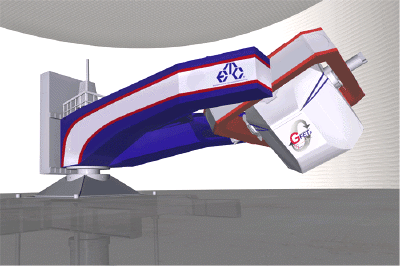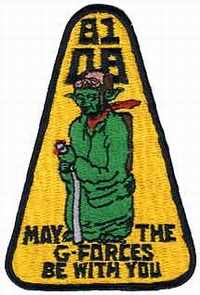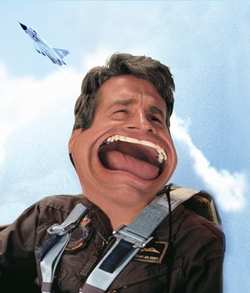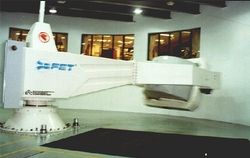Hi-G Demonstration Draws Funny Looks From Participants
Environmental Tectonics Corporation announced the AeroMedical
Training Institute's first International High Performance Human
Centrifuge (HPHC) Safety Seminar was held at ETC Headquarters in
Southampton (PA) late last month. Aeromedical and Engineering
professionals from Italy and Sweden attended.

Traditionally, human centrifuges have been low-performance
devices. Many were single-axis devices that generated G force
through centrifugal force (bottom photo). G-onset rates provided by
these centrifuges were typically low. The pilot sat in a gondola
that was on the end of the centrifuge arm. As the centrifuge
accelerated, the gondola swung out and the centrifugal force vector
became approximately aligned with the pilot's +Gz, or head to foot,
axis. A passive (resistance) damping system attempted to control
the gondola oscillations during acceleration and deceleration.
These centrifuges replicated the Gz forces experienced by the pilot
during maneuvering flight (but not the other G forces) and provided
the pilot a safe and controlled environment in which to experience
G forces and learn proper countermeasure so he could tolerate the G
forces in flight.
Not just one axis any more...
 As aircraft became more sophisticated and higher
performance, training needs changed and the demand for high
performance human centrifuges that could match aircraft performance
grew. In an effort to allow for more interactive and realistic
centrifuge training, powered multi-axis centrifuges were developed.
These modern centrifuges incorporated powered pitch and roll drive
systems, visual displays, interactive flight controls and flight
performance models to provide the pilot with an accurate and
realistic high G flying experience.
As aircraft became more sophisticated and higher
performance, training needs changed and the demand for high
performance human centrifuges that could match aircraft performance
grew. In an effort to allow for more interactive and realistic
centrifuge training, powered multi-axis centrifuges were developed.
These modern centrifuges incorporated powered pitch and roll drive
systems, visual displays, interactive flight controls and flight
performance models to provide the pilot with an accurate and
realistic high G flying experience.
Quick-onset Gs, three-axis Gs -- a safety challenge:
 In order to simulate tactical flight, these
centrifuges needed to be able to achieve high G onset rates (up to
10 G/sec) and high G levels (up to 15 G). Further, they had to be
able to generate not only Gz forces, but also Gx (front to back)
and Gy (side to side) forces. While this increase in centrifuge
performance has been necessary, it has created a situation where
the High Performance Human Centrifuge can, if not carefully
controlled, exceed the limits of human tolerance to these G forces.
Accordingly stringent safety requirements are needed in these
machines to insure the pilot would not be injured in training.
In order to simulate tactical flight, these
centrifuges needed to be able to achieve high G onset rates (up to
10 G/sec) and high G levels (up to 15 G). Further, they had to be
able to generate not only Gz forces, but also Gx (front to back)
and Gy (side to side) forces. While this increase in centrifuge
performance has been necessary, it has created a situation where
the High Performance Human Centrifuge can, if not carefully
controlled, exceed the limits of human tolerance to these G forces.
Accordingly stringent safety requirements are needed in these
machines to insure the pilot would not be injured in training.
ETC is the world leader in centrifuge safety. ETC produced their
first multi-axis centrifuge with this capability, the U. S. Navy
C-FET, in 1993. This was followed by deliveries to Singapore in
1994 and the Japanese Defense Agency in 1999.
Newest machine can do more than any aircraft (or any human, for
that matter):
 ETC's
Second Generation High Performance Human Training and Research
Centrifuge, the G-FET II (top illustration), is currently under
construction in ETC's Southampton facility. It can produce -8Gz to
+25Gz, 0 to +8 Gy, and +/-10 Gx sustained accelerations at onsets
of up to 10 G/s. The gondola is suspended in an electromechanically
powered, dual gimbaled, high performance positioning system that
responds to a programmed aeromodel and gives the device the ability
to support sustained G, Tactical Flight Simulation (TFS). The high
fidelity cockpit has closed loop flight controls, variable seat
angle capability, and wide field view, out-the-window visual
scenes. These systems are integrated through advanced computer and
control architecture and aircraft flight algorithms to produce high
fidelity, aircraft specific flight performance.
ETC's
Second Generation High Performance Human Training and Research
Centrifuge, the G-FET II (top illustration), is currently under
construction in ETC's Southampton facility. It can produce -8Gz to
+25Gz, 0 to +8 Gy, and +/-10 Gx sustained accelerations at onsets
of up to 10 G/s. The gondola is suspended in an electromechanically
powered, dual gimbaled, high performance positioning system that
responds to a programmed aeromodel and gives the device the ability
to support sustained G, Tactical Flight Simulation (TFS). The high
fidelity cockpit has closed loop flight controls, variable seat
angle capability, and wide field view, out-the-window visual
scenes. These systems are integrated through advanced computer and
control architecture and aircraft flight algorithms to produce high
fidelity, aircraft specific flight performance.
The G-FET II's Tactical Flight Simulation training capabilities
include:
- High G Tolerance Training
- Super-Maneuverable Flight
- Unusual Attitude Recovery
- Missile Avoidance
- Air Combat Maneuvers
- High-G Physiology Research
Trust your programmer and your technicians.
 Demonstrations were performed by the ETC Seminar
leaders using ETC's G-FET II High Performance Human Centrifuge
(pictured at top).
Demonstrations were performed by the ETC Seminar
leaders using ETC's G-FET II High Performance Human Centrifuge
(pictured at top).
ETC President William F. Mitchell said, "The AMTI HPHC
International Safety Seminar was a total success. Feedback from
attendees was all positive and ETC plans on making this very
important exchange an annual event. In fact, we plan to offer the
next HPHC safety seminar in October of this year."
 ANN's Daily Aero-Linx (04.15.24)
ANN's Daily Aero-Linx (04.15.24) Classic Aero-TV: 'No Other Options' -- The Israeli Air Force's Danny Shapira
Classic Aero-TV: 'No Other Options' -- The Israeli Air Force's Danny Shapira Aero-News: Quote of the Day (04.15.24)
Aero-News: Quote of the Day (04.15.24) Airborne 04.16.24: RV Update, Affordable Flying Expo, Diamond Lil
Airborne 04.16.24: RV Update, Affordable Flying Expo, Diamond Lil ANN's Daily Aero-Term (04.16.24): Chart Supplement US
ANN's Daily Aero-Term (04.16.24): Chart Supplement US







